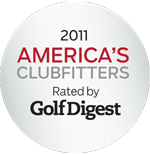Just when you thought it was safe to go back to the blogs!!! Here I am again bringing you the latest from PPGS FITTING CENTRAL. I would like to say what a pleasure it has been to meet and work with so many of you over that past couple months and I look forward to meeting more of you in the next few months. Many of you from the Inner Circle responded to the offer to get a driver like the one Don plays and the feedback has been great. Thanks to all of you that have purchased to date and for the very positive feedback on the performance of the driver. I have decided to extend the program for a few more weeks so those of you that are Inner Circle members that are interested, you can still contact me to order.
This week I had a fitting with one of our PPGS members that was rather unique in one respect but not so different from most of the others that I had done lately. The difference in this fitting was that it was with a former student of Don’s back when he was on Hilton Head. We will call this person DN. Now, DN had scheduled an appointment for a lesson and a fitting well in advance and even contacted me a few days before he was due to arrive to give me some information regarding what he was currently experiencing with his present clubs. His frustration exuded from his email. No matter what he did, he hit the ball on the toe and it was very weak and inconsistent. Does this sound familiar to any of you? Several times I have seen postings from individuals on the blog wondering why they hit the ball on the toe of their clubs and what they could do to correct it. I’ve responded several times to these pleas for help and offered plausible explanations as to what could cause it. What I am getting ready to share will probably have most of you scoffing, some of you re-reading to make sure there wasn’t a typo, and others sitting there in stunned disbelief.
After DN arrived, I examined his clubs as I do with all my clients then proceeded to hit a few shots with a couple clubs. At this point, I will tell you that the set was a very nice looking set of new Pings with graphite shafts in regular flex with standard lies. The shots I hit were fair but I had to “work” to get the club to perform as I went to the longer irons. I asked DN to hit some shots. Sure enough, everything was out on the toe and just weak. He hit about as many pushes as he did pulls. I think the best way to describe the performance was inconsistent. Since this was a lesson/fitting, I approached some of the swing issues first. When I saw that DN had a grasp of the things I was asking him to do swing wise but the shots still didn’t improve it was time to move to the fitting mode. I went back into the fitting lab as he was hitting balls and brought out a few clubs. I put one in his hand and KAPOW, immediate improvement. Even the sound was 100% better. He hit another, then another, then another. After about the 5th shot, I asked him for his evaluation. His response was that the shots were much more solid. He was able to hit the ball to his target. He could feel the club as he was swinging it. The really amusing thing to me was his comment about “even the miss-hits feel better and are more accurate”. So, what was the magic club that I gave him? I’ll tell you later. The rest of this story is that I brought out about 5 more clubs for him to try and he hit every last one of them better than he did his irons. To make it even more incredible, some of the clubs that I gave him to hit had 6.0 and 6.5 rifle shafts. For those of you not familiar with these shafts, those bad boys are like telephone poles. I need to also tell you at this point that DN’s swing speed is no where near fast and powerful and conventional wisdom would tell you that there is no way that he could hit anything with those shafts in the head. We’ve all heard that the shaft is the engine. I certainly agree with that. But, I think sometimes we try to drive the wrong car. Given the right head, DN was even able to hit very good irons shots with shafts that were way too stiff. So, what was the correct head?…………not yet.
I’m sure most of you that have been long time readers of the PPGS articles know that Don and I both are staunch supporters of smaller heads all be it drivers or irons. One of Don’s favorite questions is “if bigger is better, how come we don’t see bigger 3 woods?” I know the following may be redundant to many of the readers but I feel this bears repeating for those that are new or have not otherwise read this information before. The larger you make the head, whether driver or iron, you move the center of gravity further from the axis of rotation, the hosel, and this makes it increasingly more difficult to bring the toe back in to square up the club head. It requires more effort and force. So, for the slower swinger, lady golfer, senior golfer, or even weaker golfer, you are fighting the club in trying to square the club face up and hit a decent shot. Even with a good swing, you may never hit a good shot. Ask DN. Try as he might, the clubs he was swinging made it virtually impossible to hit a good powerful shot.
So, what was it that DN was able to hit so well. It was a BLADE! Now, for the sake of clarity, I will define what a blade is in my opinion. The concept of a BLADE is in reference to something capable of cutting. So, in order to cut, it has to be somewhat thin and sharp. So, by definition, a BLADE has a thinner, sharper line to it and is a smaller head by design. I categorize blades in two groups. You have your traditional muscle back blades and now with the advances in technology, you also have some cavity back blades. The similarity is that both are small and have thin top lines and thinner soles.
Now, at this point I’m going to address all the raised eyebrows and those that have shouted out, “hey, the manufacturers all tell us that the big head are more forgiving”. First, just what is meant by forgiving in relation to golf clubs? The consensus is that it means you get better results out of poor miss-hits. But, how can a club be forgiving if it is also responsible at the same time for causing those miss-hits? Wrap your head around that one if you will! While nobody’s swing is perfect, if you have clubs that are built correctly for you, you will not miss-hit as terribly as you have been lead to believe. I would like for everyone that is reading this that hits their clubs out on the toe constantly to raise their hand. I’d love to be able to see just how many hands went up!! The one major design factor that makes a club more game improving over another is not the size of the head but the amount of offset. Remember, you heard it here. OFFSET! Offset is one heck of an equalizer. Offset gives those with timing issues or “slow hands” a tad more time to get the club face to square. Players like Don with quick hands are negatively effected by offset. However, the majority of amateurs benefit from it.
Before I leave you with some numbers information, I’d like to share one more experience of the fitting with DN. As we got done with the irons, DN mentioned the driver fitting and that no matter what, he hit everything to the right with his driver. His driver is one of the Callaway FT series. First thing I did was let him hit a few shots. Sure enough, everything was weak right. So, what was the problem? His swing? Nope! His swing looked good still. I measured the length. TOO LONG! And, the head was too big for him to square. I went into the fitting lab and brought out one of the 355cc drivers with a shorter shaft and handed it to DN. Now, I don’t remember just how many shots he hit but he was hitting a nice high soft draw and not once did he hit any weak bleeders right. He did make a few swings where he over rotated or tried to swing harder and came over the top but even then he hit a nice fade that came back into the middle. Evaluation: Bigger and longer ain’t better!
I would like to leave you with some numbers that you might find quite unbelievable. In the last two weeks I have fit players that opted to forgo retro-fitting their current set and have a completely new set built for them. Those sets that were being played are as follows: Pings-4 sets, Cobra-1 set, Burner-1 set, Callaway-2 sets. Each player went with a set of blades as they all hit them better than the larger clunky heads that they were used to. What convinced them to go with blades? They hit them! Pure and simple. That is all it took. I asked each player had I asked them if they could hit a blade before we began the fitting what their response would have been. To the person, each one said the answer would have been no. I asked each one what their answer was now. The answer was a resounding YES!
Hopefully this information will get some thought processes started and eventually lead you to some discoveries that will enlighten you and help you find your way in the world of golf. Don’t be afraid to ask questions and to go against the grain of conventionalism. Please don’t accept with blind faith the advertising and media rhetoric that we are all bombarded with constantly on TV and in print. The primary objective of the OEMs is to keep you buying equipment and to make a profit. I’ll leave you with this question, if you really are able to “buy a better game”, then what would be the reason for you to keep buying more equipment?



I recently received a set of irons hybrids 4,5,6 irons 6,7,8,9,pw,sw,Lw 3wood and driver I’m an 8 handicap I love the clubs, I just wanted to say thanks to doc I’m hitting the ball better and more consistently solid than I ever have thanks again doc
Great report Chris and thanks so much!